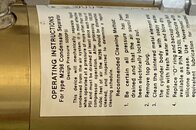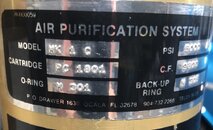It is a k14-85. They came in 4cfm and 8 cfm variants. 900 RPM pump. Probably one of the most reliable long running machines made. It was low speed, low pressure, and pressure lubricated. If you can't source the fourth stage valves, a capitano third stage head will fit. I own a few of them. If you don't mind the 3200 psi limit, it is a great compressor. That one has a nice upgrade with the separate coalescor, the original one was relatively thin walled, they had a tendency to rust through and fail. Especially when people tried to run them at higher than designed pressures.
If you have a 5 hp motor, it is most likely an 8cfm. The 4 cfm came with a 3 hp motor.
If you have a 5 hp motor, it is most likely an 8cfm. The 4 cfm came with a 3 hp motor.






